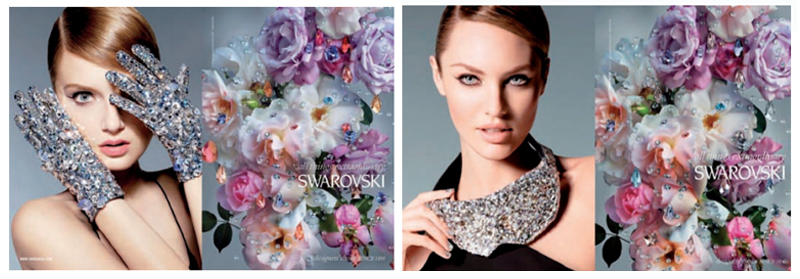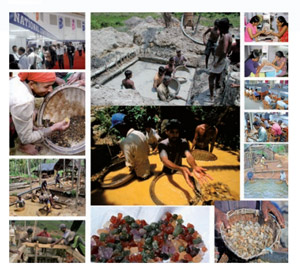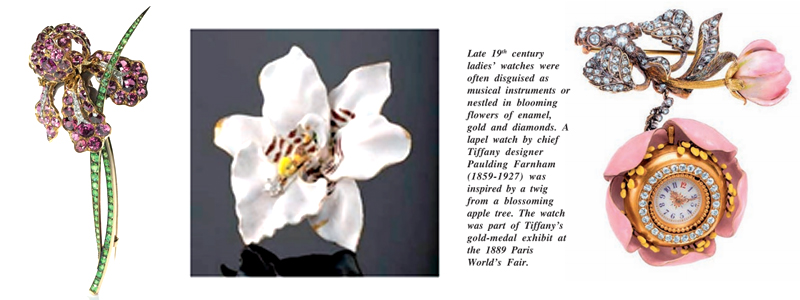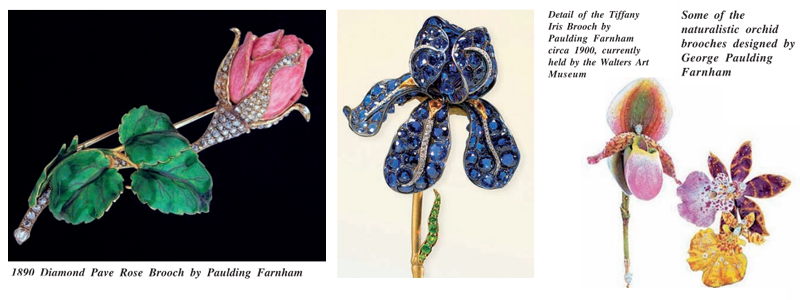|
|
Synthetic
Ruby Identifier |
|
| |
Presidium
Instruments is showcasing what it claims is the world’s
first device to detect flame fusion-created rubies at the American
Gem Trade Association.
The
Synthetic Ruby Identifier measures the ability of ultravioiet
light to pass through the stone based on the knowledge that
gemstones have a very signfiicant difference in iight admittance
ifT. are naTural versus synthetic. The device TeaTures U\/ iight
that passes Through The ruby and Tower iighT detector on The
base. Lighi‘ bars on The Tron The lid iighT up To provide
an easy reading ThciT indicaTes if The UV iighT TransmiTTance
abmTy ofi ruby is high or low.
Natural
rubies have low U\/ transmitahce because of Trace elements that
absorb The deep because of trace elements that absorb the light,
allowing for little to pass through.
Other
Types of synthetic rubies That weren't created by flame fusion
could have either high low transmittance ability, depending
on The transition metal ions inside ThaT may have been introduced
during The growTh process Asihey rare, Presidium was not abie
To get enough same for testing, and the device cannot accurately
detect those. |
|
| |
However,
it can accuraieiy detect a flamed fusion-created ruby,
according to the compo which is the most common type
of synthetic these typicaliy have few transiTion mefai
ioris Therefore aiiow more UV |ighT To pass through
The identifier is designed to work on boih singl mounted
stones as weli as loose rubies and oi for a very quick
screening process.
A Company spokesperson
said that the software is currently in beta test mode
but will be released by the time those in the United
States would reeive their identifiers in the spring.
and therefore will be available to use in tandem with
the machine.
To create the identifierdevice,
Singapore-based Presidium parthered with the Gem and
Jewelry Institute of Thailand, which provided them with
the many ruby samples used to develop it. The device
is the company's first to help identiify syhthetics.
|
|
|
|
|
| |
|
|
|
Swarovski
hosts Interactive style contest |
|
| |
Swarovski is partnering
with four international fashion bloggers to launch an interactive
online competition for consumers.
From March 22 to April 21, one bloggerwill focus on a specific
theme and look each week Each blogger will share tips and tutotial
video on how to create looks for Spring/Summer 2014. using Swarovski
jewellery on the brands's dedicated "microsite", SWarovskiLook.com
Participating contestants
are asked to share their own look of the week on Instagram with
a photo of themselves wearing Swarovski jewellery styled their
own way, using the has htag #SwarovskiLook. |
|
| |
 |
|
| |
The guest blogger
leading each weekwill choose one consumer as a winner, who will
receive three Swarovski pieces associated with the theme the
weekly winners will also be entered into the grand finale competition
, taking place on April which will be judged by the bloggers
as well as Swarovski representative.
The
guest bloggers are as follows.
- Week one will featiure Australian blogger Amber Renae from
the style engineer, with the theme "Everyday chic":
- Week two will featiure an"Urban glam" theme, featuring
Spanish blogger Priscilla Betancort of My Showroom Blog.
- Week three will feature Hong Kong blogger Mayo Wo from Mellow
Mayo, covering a "Spring look" theme;
- Week four will be U.S.blogger, stylist, and designer Jenny
Bernheim, of Mago and me, for the "More is more" theme.
"Jewellery is meant to be
playful. There are no rules and what is important is to date,
to mix it up. and to have fun. " said Swarovski's Creative
Director Nathalie Colin.
Fashion
bloggers have been gaining more influence with fashion brands
and companies in the past few years, with two other fine jewellery
brands aligning themselves with fashion bloggers over the past
few months. |
|
| |
|
|
| |
|
|
|
HRD
Antwerp Synthetic Diamond Certificats |
|
| |
|
|
| |
HRD Antwerp is launching a Laboratory Grown Diamond certificate
in the wake of recent oncerns about lab-grown diamonds
entering the market undisclosed.
In accordance with lnternational Diamond Council rules
The HRD Antwerp Laboratory Grown Diamond Certificate looks
different from the standard certificate and clearly mentions
the wording "Laboratory Grown Diamond Certificate
on the cover.
Each laboratory
grown diamond is clearly laser inscribed and the laser
inscription and the certificate including a reference
number and statement that the diamond has been lab grown.
Each laboratory grown diamond
Certificate includesthe same unique safety features as
the standard HRD Antwerp diamond cert|ficate, such as
a watermark, embossed logo fluorescent marks line structure
and a micro text.
“We
feel that it is important that consumers are properly
informed about the origin of the diamonds they buy. HRD
Antwerp’s Laboratory Grown Diamond provides an objective
and independent analysis of the diamond."
HRD Antwerp said in a statement that although lab-grown
diamonds are stili a relatively small market segment,
production is rising significantly
|
|
|
|
|
| |
|
|
|
Tanzania
Studies Sri Lanka Industry |
|
| |

|
|
Sri
Lanka 's sustainable mining practices and its gemstone
cutting and jewellery manufacturing industries were
the focus of study by a team of geologists and engineers
from Tanzania who are looking to develop an industry
strategy to benefit the rural communities in Tanzania.
The 15-member delegaiion from
the Miinistry of Energy and Minerals in Arusna, an area
with rich gemstone deposits, visited Sri Lanka in March
to study Sri Lanka’s “exemplary" industry.
The aelegation was led by the assistant commissioner
for minerals (Northern Zone) Alex A. Magayane. Tanzania
wants to develop a strategy similar to Sri Lanka‘s
practice, a spokesperson for the delegation said. ”Over
The years Sri Lanka has developed traditions that allow
mining to be done in a safe, sustainable and peaceful
way. Benefiis are dislributed in a system of sharing
among the people involved and the transactions are concluded
without disagreements and fights. There is a unique
trust among the miners and the traders. Tanzania would
like to emulate this."
During the visit, the delegation met with officials
from the National Gem and Jewellery Authority, \/isited
gem mines and lapidaries as well as jewellery manufacturing
facilities. |
|
|
| |
At a meeting with executive
commitee members of the Sri Lanka Gem and Jewellery Association
(SLGJA). The delegation discusses area for co-operation. SLGJA
inv/ited dealers from Tanzania to make use of Sri Lanka's hassle
free import procedure and bring in more rough for processing
there. They also urged the visitors to delegation to Facets
2014 in September as well as to the Gem Show planned for May
2015 during the lnternational Colored Gemstone Associations
Congress in Colombo. |
|
| |
|
|
|
Treasure
Trove at GIA Museum
By Phyllis Schiller |
|
| |
|
|
| |
Officially
established as a separate department of the Gemological Institute
of America (GIA) in 2002, the museum at the Carlsbad, California,
headquarters is, admits curator Terri Ottaway, “unconventional.”
For starters, instead of being housed in a freestanding building
or a dedicated centre, museum exhibits are integrated throughout
the hallways of the different buildings.
Which actually makes perfect sense
when you consider that while fascinating to the thousands
of visitors that the GIA plays host to annually, the displays
are also information for the many students attending classes.
From the giant 426-pound, nearly l-million-carat rutilated
quartz crystal Bahia sculpture suspended in the GIA lo‘o‘oy
to glorious examples of gemstones — such as a 75-carat
Burmese sapphire only recently returned to its lender -—
it is clearly a concept that works.
|
|
| |
|
|
| |
Prime Specimens
Some of the exhibits, focusing on
one or two pieces on loan from dealers, may stay on display
for years, or until such time as the dealers ask for them
there are larger themed encompassing 30 or 40 gems, which
are usually on view for six month.
“We have a very fun exhibit
that is used for the for the grounding space for tourists
who come in," says Ottaway. “Called Rocks,’
it’s more or less although some of the switched out
because loan. lt tells people what and where it comes can
understand that, the rest of the exhibitions will make sense.
Whatever the size of exhibit, the
criteria remains the same “We’re always trying
to find things that are going to inspire, teach and engage
our students and our about the wonders of gemmology and everything
that you can do with a gemmological backgrond." explains
Ottaway. To that end says, the goal is to showcase as much
diversity as possible and "just get super-high-quality
piece pieces or pieces that have really interesting designs."
Then, you to say very much. "You people walk up to the
and they 11 incredible it is"
|
|
| |
|
|
| |
|
|
| |
The full spectrum
The subjects of the various
exhibits featured at GIA run what Ottaway calls "the
full spectrum." One of the goals of the museum is just
to "basically show people what all the fuss is about"
when it comes to gemmology. Sometimes the theme is to
explore where gemstones originate, using incredible crystals
that visibly demonstrate where a garnet or tourmaline, diamond
or emerald comes from.
Sometimes the inspiration is closer
to home. A new series, "Aluminati: Students to Stars,”
featured at GIA graduates. It was launches in 2013 with the
work of GIA Graduate Gemologist Kara Ross, whose jewellery
has been worn by celebs on the red carpet as well as First
Lady Michelle Obama.
Along with highlighting alumni, the
museum is also looking to its history with a major exhibit
to open this May. Titled “G&G.' 80 Years of Excellence
Featuring the Artistry of Harold and Erica Van Pelt,”
it will pay tribute to the husband-and-wife photographers
whose work was featured in GIA’s scientific quarterly
journal Gems & Gemology. A variety of photographs by the
Van Pelts will be shown alongside the jewellery, alongside
the jewellery, gems, minerals and sculptures featured in each
image. Tracking down the jewellery photographed by the Van
Pelts has been, says Ottaway, “a treasure hunt. Some
pieces have disappeared, been lost, or disassembled.”
Some of the impressive pieces that will be on view include
the 300-year-old emerald and diamond Spanish Inquisition Necklace,
on loan from the Smithsonian Institution, and an amazing emerald
and diamond Schlumberger necklace. |
|
| |
|
|
| |
Past and Present
When it comes to Jewellery design,
themes span centuries. Several years ago, the museum was forttunate
enough to receive a donation of pre-Columbians Jewellery which
has been a of fascination and inspiration for students in
Jewellery manufacturing. On the other end of the time spectrum,
in 2011 there exhibit of by Hong Kong Jeweller artist Wallace
Cha, Which Ottaway calls breathtaking His designs, the gems
that he chose fact that he's working in titanium and not the
traditional elements, were just Jaw-dropping."
And speaking of stadours the exhibition
"More is More: Tony Duquette and Hutton Wikinson Jewellery"
Offered visitors a glimpse at "the more unconventional
things that aren't gem materials, like shark s teech,"
Ottaway points out, "Duquettee and Wilkinson have a ireverent
exuberance about their Jewellery that s really fun to share
with others." Although the ended in March, several pieces
are being lent for long-term display.
Another ongoing exhibit that falls
under the “something different” category is “Faces
of Etemity.” It features a collection of 15 life-size
skulls carved from gem crystals and ornamental rock by Peruvian
artist Luis Alberto Quispe Aparicio.
|
|
| |
 |
|
| |
Ultimately,
sums up Ottaway, the goal is to foster an appreciation of
gems as well as the workmanship behind the jewellery. The
exhibits, she says, can help visitors understand why in the
past “gemstones filled the coffers of kings. People
have gone to all lengths to acquire gems. For our visitors,
we want to show the intensity of feelings gemstones can evoke
and foster an appreciation for what it takes to find the right-quality
crystal and then cut it well and then design a piece of jewellery
around it. I’ve heard from so many people, ‘I
just had no idea’ that all this work and all this discovery
went into taking gems from mines to markets. These exhibits
give them a whole new appreciation.” |
|
| |
|
|
|
Paulding
Farnham's Quintessential Flowers
By Phyllis Schiller |
|
| |
|
|
| |
George
Paulding Famham — known as Paulding —- was born
on November 6, 1859, in New York City. When he was 16, with
the help of family connections -- his aunt was married to
Tiffany & Co. executive Charles Thomas Cook — he
began an apprenticeship in the studio of Tiffany’s chief
designer Edward C. Moore, which enabled him to develop his
natural talent. In 1885, Farnham was hired, eventually working
his way to head designer from 1891, after the death of Moore,
through the early 1900s. Famham left Tiffany & Co. in
1908, after Louis Comfort Tiffany took over the firm and began
implementing his own design vision. Farnham died in 1927 in
California at the age of 68.
Artistic Legacy
During his tenure at Tiffany
& Co., Farnham created an impressive array of award-winning
jewellery designs exhibited at several world expositions that
the company acclaim on an international level. Farnham also
was responsible for designs in silver and impresive private
commissions such as the Belmont Cup, Dewey Sword and Adam’s
Vase. |
|
| |
 |
|
| |
At
the age of 27, Famham designed the jewellery Tiffany &
Co. exhibited at the 1889 Expositions Universelle in Paris.
The pieces encompassed a Renaissance Revival styles, native-American-themes
pieces and creations that were inspired by Oriental Islamic
art, along with a series of dramatically life enamel and gemstone
orchids, which captured the prize for jewellery. “The
flowers were in the style naturalism,” says Janet Zapata,
jewellery hist “but Farnham also turned to revival styles
of cultures — he did them all.”
“You have to take Farnham’s
designs in context of the era in which he grew up,”
says Elkins, senior vice president, Sotheby’s jewellery
department, New York, “and the various revival styles
taking place. He was a consummate artist in terms of things
that were Renaissance Revival. He was coming out of the tradition
of natuaralism. He was experimental in design in creating
these amazing lifelike flowers." |
|
| |
 |
|
| |
Farnham's
diamond-centric pieces included a large, lacy looking corsage
ornament made for the points out Zapata, with more than 2,000
diamonds mounted in platinum, as well as a necklace whose
leaves and blossoms were after the American hazelnut, its
centre diamond weighing 25-plus carats. But, Zapata says,
while the diamond jewellery exhibited was valued at $500,000,
an impressive sum at that time, it was the enamel work orchids
that caused the most sensation. "There flowers were all
perfect reproductions since they were based on real fowers.”
"In the mid-19th century,
you had some fabulous jewellers working in diamonds and silver,”
points out Elkins, “but in terms of the enamelwork,
Farnham truly did groundbreaking work with the flowers he
designed, and I think what he will always be known for are
the orchids. They were such a huge international splash when
they were launched in 1889 at the exposition and that is what
put him on the map.” |
|
| |
A
Bouquet of Flowers
The interest in flowers,
says Zapata, “was very strong in the late-19th
century. A lot of these fowers weren’t seen in
the West until then, appearing first in Europe, then
America. For instance, the chrysanthemum that we take
for granted today wasn’t introduced until 1856.
The different flowers each represented specific sentiments
or meanings. Designers took advantage of that interest
and began replicating flowers’ beauty in jewellery.
What Farnham did was more full-blown, naturalistic,
not realistic. It looked like the flower itself had
been dipped in gold.”
Farnham’s orchids
represented 25 species native to a variety of countries
including Mexico, Brazil, Colombia, Guatemala, India
and Philippines, explains Zapata, and so closely followed
nature that a reviewer stated they had to be touched
to ascertain they were jewellery and not the real thing.
The stamens and petals were accented with diamonds;
the stems were paved with diamonds and rubies. In fact,
says Zapata, their true-to-bloom appearance was said
to have caught the eye of financier Jay Gould, a private
collector of living orchids, who added the bejewelled
examples to his collection.
Auction Standouts
Jewellery designed by
Farnharm doesn't come up at auction or in the marketplace
very often, says Elkins. "On average, you might
see an orchid or two within a decade. So that what one
is available, it can command an impressive price."
|
|
|
|
|
| |
Elkins cites a
pink orchid that sold at Sotheby's York in October 1993, estimated
at $20,000 to $30,000. “It was a shot that rang round
the world when it sold for astonishing $415,000.” Just
this past December, a smaller orchid, shown here, with its original
case, estimated at $80,000 to $120,000, sold for $173,000, "I
can't say for sure whether it was part of the 1889 exhibition,”
Elkins says. The company did do re-issues the following year
in New York and Famhamadd more varieties.
Farnham’s jewellery, notes Elkins, has an audience of
“serious buyers” and “if there hasn’t
been market for a very long time, they’re hungry”
to own one that comes up for sale. But, she says, "anyone
can be drawn to these pieces, especially when it’s something
interesting attributed to his design under the aegis of Tiffany." |
|
| |
|
|
| |
|
|
| |
|
|
|
|